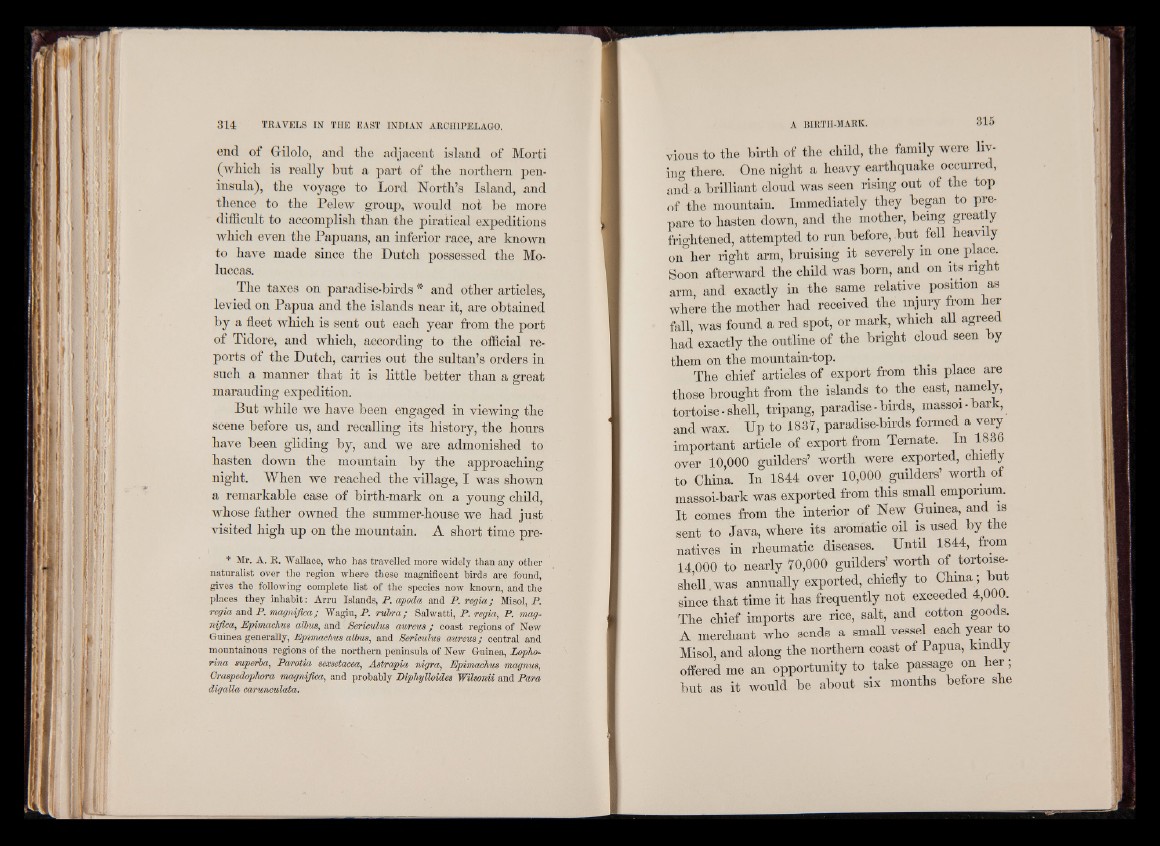
end of Gilolo, and tlie adjacent island of Morti
(which is really but a part of the northern peninsula),
the voyage to Lord North’s Island, and
thence to the Pelew group, would not be more
difficult to accomplish than the piratical expeditions
which even the Papuans, an inferior race, are known
to have made since the Dutch possessed the Moluccas.
The taxes on paradise-birds * and other articles,
levied on Papua and the islands near it, are obtained
by a fleet which is sent out each year from the port
of Tidore, and which, according to the official reports
of the Dutch, carries out the sultan’s orders in
such a manner that it is little better than a ogreat
marauding expedition.
But while we have been engaged in viewing the
scene before us, and recalling its history, the hours
have been gliding by, and we are admonished to
hasten down the mountain by the approaching
night. When we reached the village, I was shown
a remarkable case of birth-mark on a young child,
whose father owned the summer-house we had just
visited high up on the mountain. A short time pre*
Mr. A. E. Wallace, who has travelled more widely than any other
naturalist over the region where these magnificent birds are found,
gives the following complete list of the species now known, and the
places they inhabit: Arru Islands, P. apoda and P. regia; Misol, P.
regm and P. magnifiea; Wagiu, P. rubra; Salwatti, P. regia, P. mag-
nifica, Epimachus adms, and Sericulus aureus ; coast regions of Mew
Guinea generally, Epimachus albus, and Sericulus aureus; central and
mountainous regions of the northern peninsula of Mew Guinea, Lopho-
rina superba, Parotia sexsetacea, Astrapia nigra, Epimachus magnm,
Graspedophora magnifiea, and probably Biphylloides Wilsonii and Para
digalla carunculata.
vious to the birth of the child, the family were liv-
ing there. One night a heavy earthquake occurred,
and a brilliant cloud was seen rising out of the top
of the mountain. Immediately they began to prepare
to hasten down, and the mother, being greatly
frightened, attempted to run before, but fell heavily
on her right arm, bruising it severely in one place.
Soon afterward the child was bom, and on its right
arm, and exactly in the same relative position as
where the mother had received the injury from her
fall was found a red spot, or mark, which all agreed
had exactly the outline of the bright cloud seen by
them on the mountain-top. I
The chief articles of export from this place are
those brought from the islands to the east, namely,
tortoise-shell, tripang, paradise-birds, massoi-bark,
and wax. Up to 1837, paradise-birds formed a very
important article of export from Temate. In 1836
over 10,000 guilders’ worth were exported, chiefly
to China. In 1844 over 10,000 guilders’ worth of
massoi-bark was exported from this small emporium.
It comes from the interior of New Guinea, and is
sent to Java, where its aromatic oil is used by the
natives in rheumatic diseases. Until 1844, from
14,000 to nearly 70,000 guilders’ worth of tortoiseshell
was annually exported, chiefly to China; but
since'that time it has frequently not exceeded 4,000.
The chief imports are rice, salt, and cotton goods.
A merchant who sends a small vessel each year to
Misol, and along the northern coast of Papua, kindly
offered me an opportunity to take passage on h e r;
but as it would be about six months before she